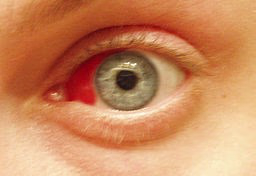Subconjunctival haemorrhage
Peer reviewed by Dr Colin Tidy, MRCGPLast updated by Dr Suchita Shah, MRCGPLast updated 8 Jul 2022
Meets Patient’s editorial guidelines
In this series:Eye problemsInfective conjunctivitisAllergic conjunctivitisDry eyesEpiscleritis and scleritisUveitis
A subconjunctival haemorrhage is one common cause of a red eye. It is caused by a small bleed behind the covering of the eye. It can look alarming but it usually causes no symptoms and is usually harmless. The redness usually clears within two weeks.
In this article:
Continue reading below
What is a subconjunctival haemorrhage?
Subconjunctival haemorrhage: "Red eye"

By Standardissue at en.wikipedia, CC BY-SA 3.0, via Wikimedia Commons
The conjunctiva is like a thin 'skin' on the front of the eyeball. It covers the white part of the eye (the sclera) but does not cover the central part of the eye (the cornea).
In between the conjunctiva and the sclera run tiny blood vessels. If you look closely at the sclera you may just be able to see a few tiny blood vessels.
If one of these tiny blood vessels bursts, it bleeds in between the conjunctiva and the sclera. This bleed is called a subconjunctival haemorrhage.
What causes a subconjunctival haemorrhage?
In the vast majority of cases there is no apparent cause. They occur more often in older people and also happen frequently in healthy newborn babies.
Occasionally, a subconjunctival haemorrhage can be caused by an injury to the eye or a head injury. Sometimes they occur after a bout of coughing or being sick (vomiting). They are associated with other medical conditions such as high blood pressure (hypertension),diabetes mellitus and coronary heart disease. If you have a bleeding disorder, such as haemophilia, or if you take anticoagulant medication (blood thinners such as warfarin), you may be more prone to getting a subconjunctival haemorrhage (or other bleeding such as nosebleeds or easy bruising).
Continue reading below
What are the symptoms of a subconjunctival haemorrhage?
Usually none. You often do not notice it until someone points it out to you, or you see it in a mirror. It can be alarming, as sometimes a large part of the white of the eye (sclera) appears bright red. This is because the tiny bleed (haemorrhage) spreads between the thin 'skin' on the front of the eyeball (the conjunctiva) and the sclera in a thin film. It looks a lot worse than it really is! Your eye might feel mildly irritated but your vision should be entirely normal. It is not uncommon for it to happen again at a later date.
What is the treatment for a subconjunctival haemorrhage?
Unless there is an underlying medical problem, no treatment is required. It will usually fade and disappear within two weeks. (Like any other bruise, the red colour will go a yellow/brown colour before it fades away.) If your eye feels irritated, you can use artificial tears. It is best to avoid drugs like ibuprofen, which can make bleeding worse. Do mention to your doctor if:
You have not had your blood pressure checked recently.
You suspect an injury to your eye is the cause (for example, a small bit of flying metal from a hammer, chisel, etc).
You have noticed any other unusual bleeding or bruising on your body for no good reason.
Continue reading below
How to prevent a subconjunctival haemorrhage
There are some steps you can take to help prevent subconjunctival haemorrhage or indeed, eye injury. These include:
Wear protective eyewear during sports or DIY where debris may enter your eye.
Insert and remove your contact lenses properly and keep them clean.
Get medical advice from your doctor if you suspect you have a bleeding disorder.
Avoid rubbing your eyes.
Further reading and references
- Cronau H, Kankanala RR, Mauger T; Diagnosis and management of red eye in primary care. Am Fam Physician. 2010 Jan 15;81(2):137-44.
- Tarlan B, Kiratli H; Subconjunctival hemorrhage: risk factors and potential indicators. Clin Ophthalmol. 2013;7:1163-70. doi: 10.2147/OPTH.S35062. Epub 2013 Jun 12.
- Doshi R, Noohani T; Subconjunctival Hemorrhage. StatPearls, Jan 2022.
Article History
The information on this page is written and peer reviewed by qualified clinicians.
Next review due: 7 Jul 2027
8 Jul 2022 | Latest version

Feeling unwell?
Assess your symptoms online for free